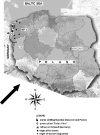Fluoride in the bones of foxes (Vulpes vulpes Linneaus, 1758) and raccoon dogs (Nyctereutes procyonoides Gray, 1834) from North-Western Poland
- PMID: 24869802
- PMCID: PMC4065378
- DOI: 10.1007/s12011-014-0017-5
Fluoride in the bones of foxes (Vulpes vulpes Linneaus, 1758) and raccoon dogs (Nyctereutes procyonoides Gray, 1834) from North-Western Poland
Abstract
Assessment of exposure to fluoride (F(-)) is increasingly focused on mineralized tissues, mainly bones. Their periodic growth and continuous reconstruction make them a good material for studying long-term F(-) accumulation. In this study, F(-)concentrations were determined in the bones of foxes and raccoon dogs from north-western Poland and relationships between bone F(-) and the age categories of the animals were attempted to be identified. Bone samples were collected from femurs of 32 foxes (15 males and 17 females) and 18 raccoon dogs (10 males and 8 females) from polluted, medium-polluted, and unpolluted by F(-) areas. Bone F(-) was determined by potentiometric method, and results were expressed per dry weight (dw); they ranged from 176 to 3,668 mg/kg dw in foxes and from 84 to 1,190 mg/kg dw in raccoon dogs. Foxes from north-western Poland accumulated much more F(-) in their bones than raccoon dogs. Our study shows that the assessment of hazards created by industrial emitters can be conducted conveniently by the measurements of fluorine content in hard tissues of wild animals. Due to availability of such type of material for studies, it seems that the analysis of fluoride content in bones can be a good tool in the development of ecotoxicology.
Figures
Similar articles
-
[Comparison of fluoride concentrations in human, dog, fox and raccoon dog bones from northwestern Poland].Pomeranian J Life Sci. 2015;61(3):319-28. Pomeranian J Life Sci. 2015. PMID: 27344876 Polish.
-
Mercury Content in Organs and Tissues of Indigenous (Vulpes vulpes L.) and Invasive (Nyctereutes procyonoides Gray.) Species of Canids from Areas Near Cherepovets (North-Western Industrial Region, Russia).Bull Environ Contam Toxicol. 2016 Oct;97(4):480-5. doi: 10.1007/s00128-016-1891-7. Epub 2016 Jul 20. Bull Environ Contam Toxicol. 2016. PMID: 27437948
-
Detection of Anaplasma phagocytophilum in red foxes (Vulpes vulpes) and raccoon dogs (Nyctereutes procyonoides) from Brandenburg, Germany.Ticks Tick Borne Dis. 2014 Apr;5(3):277-80. doi: 10.1016/j.ttbdis.2013.11.001. Epub 2014 Jan 17. Ticks Tick Borne Dis. 2014. PMID: 24512760
-
Efficacy and bait acceptance of vaccinia vectored rabies glycoprotein vaccine in captive foxes (Vulpes vulpes), raccoon dogs (Nyctereutes procyonoides) and dogs (Canis familiaris).Vaccine. 2008 Aug 26;26(36):4627-38. doi: 10.1016/j.vaccine.2008.06.089. Epub 2008 Jul 11. Vaccine. 2008. PMID: 18620017 Review.
-
[Fluorides in the human bones – selected issues].Pomeranian J Life Sci. 2016;62(1):53-9. Pomeranian J Life Sci. 2016. PMID: 29533588 Review. Polish.
Cited by
-
The Effect of Risk Factors on the Levels of Chemical Elements in the Tibial Plateau of Patients with Osteoarthritis following Knee Surgery.Biomed Res Int. 2015;2015:650282. doi: 10.1155/2015/650282. Epub 2015 Oct 25. Biomed Res Int. 2015. PMID: 26583123 Free PMC article.
References
-
- Dobrzanski Z, Gorecka H. Fluorine in poultry nutrition. Drobiarstwo Pol. 2001;3:13–15.
-
- Inoue M, LeGeros RZ, Inoue M, Riviera RS, Sathi GA, Tsujigiwa H, et al. Fluoride supplement affects bone mineralization in young rats. J Hard Tissue Biol. 2006;15:61–64. doi: 10.2485/jhtb.15.61. - DOI
-
- Ghosh A, Mukherjee K, Ghosh SK, Saha B. Sources and toxicity of fluoride in the environment. Res Chem Intermed. 2013;39:2881–2915. doi: 10.1007/s11164-012-0841-1. - DOI
-
- Harrison PTC. Fluoride in water: a UK perspective. J Fluor Chem. 2005;126:1448–1456. doi: 10.1016/j.jfluchem.2005.09.009. - DOI
Publication types
MeSH terms
Substances
LinkOut - more resources
Full Text Sources
Other Literature Sources


